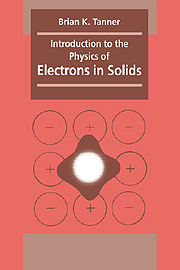Book contents
- Frontmatter
- Contents
- Preface
- Acknowledgements
- 1 The classical free electron model
- 2 Quantum mechanical free electron model
- 3 Application of the Fermi gas model
- 4 Energy bands
- 5 Experimental evidence for band structure and effective mass
- 6 Electrical conduction in semiconductors and insulators
- 7 Semiconductor devices
- 8 Localized electrons
- 9 Magnetism
- 10 Superconductivity
- Appendix 1 Elements of kinetic theory
- Appendix 2 Elements of statistical mechanics
- Appendix 3 Derivation of the Landé g factor
- Index
- Frontmatter
- Contents
- Preface
- Acknowledgements
- 1 The classical free electron model
- 2 Quantum mechanical free electron model
- 3 Application of the Fermi gas model
- 4 Energy bands
- 5 Experimental evidence for band structure and effective mass
- 6 Electrical conduction in semiconductors and insulators
- 7 Semiconductor devices
- 8 Localized electrons
- 9 Magnetism
- 10 Superconductivity
- Appendix 1 Elements of kinetic theory
- Appendix 2 Elements of statistical mechanics
- Appendix 3 Derivation of the Landé g factor
- Index
Summary
Most textbooks on solid state physics begin the exposition from what might be called a ‘structural position’. Space and point groups are discussed, followed by consideration of the Bravais lattice. The reader is thus led on to elementary ideas about crystallography and the use of diffraction techniques for the solution of crystal structures. Having laid the foundation of how atoms and molecules order to form crystalline structures, electron motion in such periodic structures is treated and band theory developed. The free electron model is seen as an approximation of the more general band theory. In many, rather formal, ways this approach is very satisfying. It would seem obvious that in the first instance one must understand the structure of the material on which one is working before attempting to understand its other physical properties. However, in practice, it proves rather hard to teach solid state physics this way and to retain student enthusiasm in the early stages of the teaching of crystallography where one is dealing with rather difficult geometrical concepts and very little physics. There is a very real danger of making the introduction to the subject so unexciting that the inspiration is lost and students come to regard solid state physics as the ‘dull and dirty’ branch of their physics course. However, elementary quantum mechanics, including the one-dimensional solution of the time independent Schrödinger equation, is included quite early in many undergraduate courses and there is much attraction in illustrating at this early stage the important technological context of the apparently abstruse quantum mechanics.
- Type
- Chapter
- Information
- Introduction to the Physics of Electrons in Solids , pp. xiii - xviPublisher: Cambridge University PressPrint publication year: 1995

